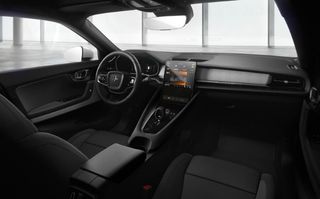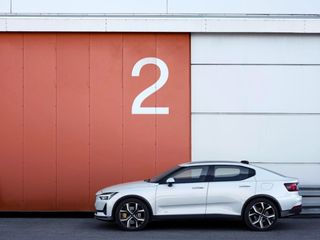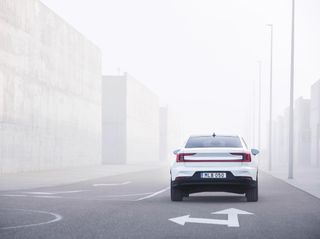
For the past few years, if you wanted to buy a luxury electric vehicle, you really could only find one company selling them. But now many other automakers are coming for Tesla’s high-end, battery-powered market, and so consumers that don’t live and breathe car statistics will have to determine what makes one EV better than the other. Do you focus on battery range and brake horsepower, or tech gadgets like the infotainment touchscreen or potential self-driving systems?
Enter Polestar, an EV car brand and spin-off of the Volvo Car group that treats innovation as more than just a marketing buzzword. This February it announced that the Polestar 2, its first all-electric car, will launch worldwide in summer 2020.
While the Polestar 2’s reported specs—500km/275mi range per charge, regenerative braking with one-pedal driving, acceleration from 0–60mph in under 5 seconds—will excite the car geeks reading this, the other tech geeks only vaguely impressed by these numbers can take heart. Polestar has geared its car (pun intended) completely towards tech geeks. Its native Android app and Google Assistant support, unique touchscreen UI, smartphone car key and subscription ownership option should appeal to anyone that thinks their car should have as much brain power as horsepower.
Don’t tap apps and drive

With an 11.5-inch vertical touchscreen just above the hexagonal gear shifter, it’s easier than ever for a driver to access apps while they drive to work. But Polestar’s engineers had the sense to realize this wasn’t necessarily a good thing.
“UIs tend not to be driver oriented,” says Amil Gasanin, the graphic designer responsible for the Polestar 2 UI design. “They also have comparatively small touch areas, taking more of your attention which should be on the road.”
So Gasanin and his team designed a four-tile grid system, making your most commonly used apps easy to find and tap without having to take your concentration off the road for longer than a second. Plus, you can customize which three buttons (see the light-gray icons above) are constantly visible for each app, since you know best what you need to endure your morning commute.
You can see how the UI looks on your phone or tablet with this sample web app Polestar made.

Unlike most infotainment screens that use a proprietary UI and quickly become obsolete, the Polestar tablet uses an Android OS that can receive wi-fi updates at any time, ensuring it (and your car) stay up to date. Polestar will even let you connect your Google Play account to the car so you can download your favorite apps.
Polestar has an ambitious plan to design its Android Automotive OS specifically for the in-car experience. It launched its own developer portal, where engineers can develop apps using their Emulator and dev tools, specifically designed for hands-free users. Then those devs can pitch their apps and ideas to Polestar and form partnerships to create a better in-car user experience.
Your favorite apps like Google Maps and Spotify will be redesigned for in-car use, keeping you safe from distraction, and other new apps will provide features that you wouldn’t need anywhere else except in a car. Some examples Polestar suggested to developers include a tool for finding and paying for parking without leaving your EV or daily briefings that mix in your appointments with the daily news.
Whatever the devs come up with, the OS will ship with features to ensure you don’t have to take your eyes off the road. The tablet comes embedded with Google Assistant support and natural speech recognition. And the Polestar 2 employs an audio environment from Harman Kardon, which specializes in smart speakers with GA support. So your voice commands should suffice until you reach your destination.
Subscribe to the Polestar experience

Being your own auto expert used to be an adult rite of passage, and even now plenty of car owners scoff at people who can’t change a tire and spend all their time fixing up vintage muscle cars in their driveway.
But some folks would much rather spend time building computer rigs than endlessly fixing an engine. For them, owning a car should mirror the Forza Horizon experience: you never haggle with aggressive salespeople, cars arrive at your location with the tap of a button, check engine lights don’t exist, and you can somehow afford high-end cars. We don’t have the time, or inclination, to become masters and experts of every aspect of our lives; we’d rather be users of a streamlined experience.
Thankfully, Polestar figured out that our love of “Netflix for _______” subscription services can and should extend to car ownership. They’ve abandoned the dealership model for an online-only vehicle purchasing service. And if you’re not ready to buy a Polestar 2 just yet, you’ll be able to subscribe to one via a Polestar subscription service due out sometime in the second half of 2019.
Your offer would vary based on your country of origin and the details aren’t final, but here’s the core of the idea: for a monthly fee, you’ll receive your own Polestar 2 EV to drive around, along with some essential complementary services to keep it running smoothly.
All of the annoying nickel-and-dime fees that comes with owning a car—driver’s insurance, maintenance costs, roadside assistance, even concierge services—will all theoretically be covered by that one subscription fee. Plus, all of these perks would be requestable through the same app you’ll use to unlock your car, no phone calls or website searches required.
Download your car keys

Plenty of automakers have given up on car keys in favor of a fob and a start button. But Polestar decided this wasn’t far enough and just got rid of those too. Instead you’ll just use your smartphone to unlock and start your car, the same way you use it for everything else.
With the Polestar Connect app enabled on your phone, your car will wake up at your approach, sensing when you are less than ten meters away. However, it won’t unlock until you touch the door handle. Once inside, you simply need to change gears and activate the brake, and your car will start on its own.
During your drive, you don’t want your “car key” to run out of juice, so you can use the wireless charging tray to keep your smartphone topped off at all times. Then, if you needed to, say, have a valet drive your car into the lot, you could use your Connect app to give his or her phone access as a temporary key.
Don’t worry: if the valet (or anyone) breaches trust and decides to go on a Ferris Bueller-style joyride with your car, you can always revoke their access.
Polestar’s bright future

Techradar frequently covers Volvo’s groundbreaking designs, including in-car cameras for monitoring intoxicated drivers, self-driving Volvo Ubers, and an online-only car purchasing app, among others. It’s no wonder that its EV offshoot would follow its lead and take a similar approach towards breaking the paradigms of car-making.
Polestar 2’s upgradeable tablet UI should keep the car running smoothly, and leave open the possibility that Polestar will add neat new tricks years past your purchase. Or, if buying any car you haven’t tested thoroughly isn’t appealing, you have the option to subscribe for a month or two and see if the car lives up to its reputation.
Get daily insight, inspiration and deals in your inbox
Get the hottest deals available in your inbox plus news, reviews, opinion, analysis and more from the TechRadar team.
